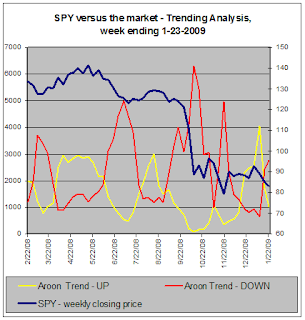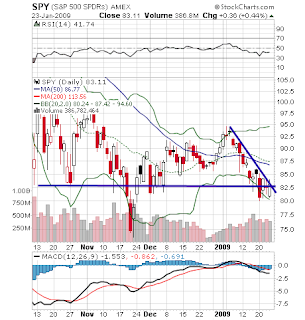Well, there was no Obama rally last week despite all the hooplah over the inauguration. On the contrary, markets dived several more percent.
Interestingly, the U.S. market was somewhat spooked by international happenings this week. The situation with banks and their need for bail-outs in the U.K. sent chills down the backs of U.S. investors. Nationalization became a hot blog topic and U.S. financial stocks went into a tailspin. The fact that most U.S. banks reporting earnings this week revealed still more writedowns and ever higher loan loss reserves certainly didn't help sentiment in the financial sector which dropped another 7%. Other international developments included major declines in GDP in both the U.K. and China. South Korea saying maybe U.S. treasuries were no longer a buy helped put pressure on our bond market.
News was mixed in the tech sector though it tilted mostly negative. Apple beat, Google did well but investors focused on Microsoft who missed expectations, withdrew all guidance and announced layoffs. A myriad of smaller tech companies did pretty much the same.
In the world of economic reports the news continued to be grim. Housing starts fell to the lowest level since 1959. Every bottom in housing seems to be followed by a lower bottom. Initial jobless claims jumped up to 589K, higher than expected. After two light holiday weeks, it appears that companies have gone back to slashing payrolls.
With all this going on, it's no wonder that the TradeRadar statistics are taking a more bearish stance.
This first chart presents the moving average analysis for the entire market and contrasts it with the performance of the S&P 500 SPDR (SPY). When the number of stocks trading above their 50-day moving average (the yellow line) crosses the line that tracks the number of stocks whose 20-day moving average is above their 50-day moving average (the magenta line) there is an expectation that you will get a change in the trend of the S&P 500.

This chart is alarming. In just two weeks, the number of stocks over their 50-day MA dropped from over 3500 to just barely over 2000. The trend of the magenta line showing the number of stocks whose 20-day MA is above their 50-day MA has turned negative. The yellow line has crossed below the majenta line. Implication: bearish
This next chart is based on Aroon Analysis and compares our trending statistics to the performance of SPY. We use Aroon to measure whether stocks are in strong up-trends or down-trends. The number of stocks in down-trends is indicated by the red line and the number of stocks in up-trends is indicated by the yellow line.

The number of stocks in down-trends now clearly exceeds the number of stocks in up-trends. Both still have room to run before they hit an extreme. Implication: bearish
The next chart applies some standard technical indicators to the stocks in the S&P 500 and summarizes the result by sector.

For those of you who saw the same chart in last week's post, you will see that all the indicators have declined even further for almost all the sectors. The only exception is the Energy sector which showed a little life this week as the price of oil perked up on Friday.
As we've compared our indicators to SPY, the S&P 500 SPDR ETF, it is worth taking a look at its chart.

It appears that SPY is at a crucial juncture here. The horizontal blue line indicates support-resistance. SPY has fallen below the line but recovered by end of week to just barely above. The blue downward sloping trend line is also in play. The decline in SPY has slowed and the price is now bumping up against this trend line. MACD is bearish but it is also slowing its descent. Failure to move above the levels indicated here could easily mean revisiting the lows established in November.
On the economic front, there are a ton of reports being released this week: existing home sales, leading indicators, consumer confidence, durable goods orders, new home sales, advance GDP for Q4-2008, Chicago PMI and Michigan consumer sentiment. None are expected to signal a significant turn for the better.
Finally, we are in the thick of earnings season. With a bunch of banks already done reporting, perhaps this week won't suffer from the negativity that the financials always bring to the party.
Interestingly, the U.S. market was somewhat spooked by international happenings this week. The situation with banks and their need for bail-outs in the U.K. sent chills down the backs of U.S. investors. Nationalization became a hot blog topic and U.S. financial stocks went into a tailspin. The fact that most U.S. banks reporting earnings this week revealed still more writedowns and ever higher loan loss reserves certainly didn't help sentiment in the financial sector which dropped another 7%. Other international developments included major declines in GDP in both the U.K. and China. South Korea saying maybe U.S. treasuries were no longer a buy helped put pressure on our bond market.
News was mixed in the tech sector though it tilted mostly negative. Apple beat, Google did well but investors focused on Microsoft who missed expectations, withdrew all guidance and announced layoffs. A myriad of smaller tech companies did pretty much the same.
In the world of economic reports the news continued to be grim. Housing starts fell to the lowest level since 1959. Every bottom in housing seems to be followed by a lower bottom. Initial jobless claims jumped up to 589K, higher than expected. After two light holiday weeks, it appears that companies have gone back to slashing payrolls.
With all this going on, it's no wonder that the TradeRadar statistics are taking a more bearish stance.
TradeRadar Alert HQ Stock Market Statistics --
Each week our Alert HQ process scans over 7400 stocks and ETFs and records their technical characteristics. Primarily we look for BUY and SELL signals for our free stock alerts; however, we also summarize the data in order to gain insights in the week's market action. The following charts are based on daily data and present the state of some of our technical indicators.This first chart presents the moving average analysis for the entire market and contrasts it with the performance of the S&P 500 SPDR (SPY). When the number of stocks trading above their 50-day moving average (the yellow line) crosses the line that tracks the number of stocks whose 20-day moving average is above their 50-day moving average (the magenta line) there is an expectation that you will get a change in the trend of the S&P 500.
This chart is alarming. In just two weeks, the number of stocks over their 50-day MA dropped from over 3500 to just barely over 2000. The trend of the magenta line showing the number of stocks whose 20-day MA is above their 50-day MA has turned negative. The yellow line has crossed below the majenta line. Implication: bearish
This next chart is based on Aroon Analysis and compares our trending statistics to the performance of SPY. We use Aroon to measure whether stocks are in strong up-trends or down-trends. The number of stocks in down-trends is indicated by the red line and the number of stocks in up-trends is indicated by the yellow line.
The number of stocks in down-trends now clearly exceeds the number of stocks in up-trends. Both still have room to run before they hit an extreme. Implication: bearish
The next chart applies some standard technical indicators to the stocks in the S&P 500 and summarizes the result by sector.
For those of you who saw the same chart in last week's post, you will see that all the indicators have declined even further for almost all the sectors. The only exception is the Energy sector which showed a little life this week as the price of oil perked up on Friday.
As we've compared our indicators to SPY, the S&P 500 SPDR ETF, it is worth taking a look at its chart.

It appears that SPY is at a crucial juncture here. The horizontal blue line indicates support-resistance. SPY has fallen below the line but recovered by end of week to just barely above. The blue downward sloping trend line is also in play. The decline in SPY has slowed and the price is now bumping up against this trend line. MACD is bearish but it is also slowing its descent. Failure to move above the levels indicated here could easily mean revisiting the lows established in November.
Conclusion --
The technical picture as described above ranges from outright bearish to "could go either way". What could provide the spark the would ignite a strong move upward? Probably the only impetus for a serious rally would be some kind of market-friendly announcement from Washington. In the meantime, stocks are due for a bounce and a few good earnings reports might do the trick and get the market moving for a few days. Still, the overall outlook is not positive for the near term.On the economic front, there are a ton of reports being released this week: existing home sales, leading indicators, consumer confidence, durable goods orders, new home sales, advance GDP for Q4-2008, Chicago PMI and Michigan consumer sentiment. None are expected to signal a significant turn for the better.
Finally, we are in the thick of earnings season. With a bunch of banks already done reporting, perhaps this week won't suffer from the negativity that the financials always bring to the party.
Comments
Post a Comment